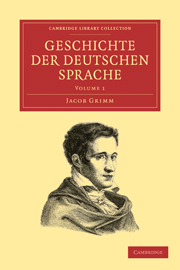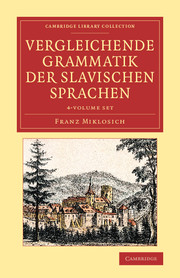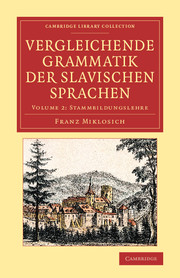Geschichte der deutschen Sprache 2 Volume Paperback Set
Jacob Grimm (1785–1863) became a household name around the world through the collections of fairy tales he compiled with his brother Wilhelm. Jacob's specialism was the history of the German language, which he studied in the broader context of Indo-European philology. Others working in this burgeoning field included the older scholar Rasmus Rask and Grimm's contemporary Franz Bopp (also published in this series). Grimm's two-volume Geschichte der deutschen Sprache, reissued here, was first published in 1848. It is noteworthy especially for the chapter on the major sound shift now known as Grimm's Law or die erste deutsche Lautverschiebung, which sets out regular mappings between Germanic consonants and those found in earlier Indo-European languages, such as English father and Latin pater. The book also contains a wealth of comparative material on phonology, vocabulary and grammar within Germanic and across the Indo-European spectrum.
Product details
February 2010Multiple copy pack
9781108006637
1065 pages
323 × 250 × 70 mm
1.8kg
Temporarily unavailable - available from TBC
Table of Contents
- Volume I: Preface
- 1. Zeitalter und Sprachen
- 2. Hirten und Ackerbauer
- 3. Das Vieh
- 4. Die Falkenjagd
- 5. Ackerbau
- 6. Feste und Monate
- 7. Glaube Recht Sitte
- 8. Einwanderung
- 9. Thraker und Geten
- 10. Skythien
- 11. Urverwandtschaft
- 12. Vocalismus
- 13. Die Spiration
- 14. Die Liquation
- 15. Die Stummen
- 16. Die Lautabstufung
- 17. Die Lautverschiebung
- 18. Die Gothen
- 19. Die Hochdeutschen
- 20. Die Franken
- Volume II:
- 21. Die Hessen und Bataven
- 22. Hermunduren
- 23. Die Niederdeutschen
- 24. Friesen und Chauken
- 25
- Langobarden und Burgunden
- 26. Die Übringen Oststämme
- 27. Scandinavien
- 28. Die Edda
- 29. Germanen und Deutsche
- 30. Rückblick
- 31. Deutsche Dialekte
- 32. Der Ablaut
- 33. Die Reduplication
- 34. Schwache Verba
- 35. Verschobnes Praeteritum
- 36. Die Vocale der Declination
- 37. Der Instrumentalis
- 38. Schwache Nomina
- 39. Der dualis
- 40. Recht und Link
- 41. Milch und Fleisch
- 42. Schluss.










